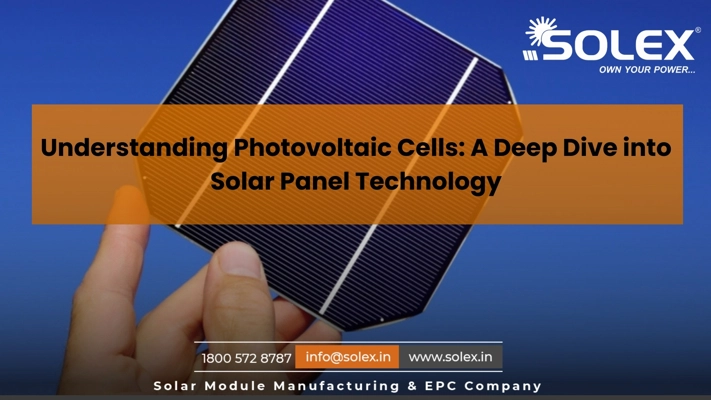In an era where sustainable energy solutions are gaining prominence, solar power stands out as a key player in the quest for cleaner and more environmentally friendly alternatives. At the heart of solar power generation lie photovoltaic cells, the building blocks of solar panels. Let’s journey to understand the intricacies of photovoltaic cells and explore the technology that harnesses the sun’s energy to power our homes and industries.
The Basics of Photovoltaic Cells
Photovoltaic cells, often called solar cells, are semiconductors that convert sunlight directly into electricity. The term “photovoltaic” originates from the Greek words “photo,” meaning light, and “voltaic,” referring to electricity. The fundamental principle behind their operation is the photovoltaic effect, first discovered by Alexandre-Edmond Becquerel in 1839.
The Photovoltaic Effect:
When certain materials are exposed to sunlight, they release electrons, generating an electric current. This phenomenon occurs in semiconductors, typically made of silicon. Silicon’s unique properties allow it to conduct electricity when exposed to sunlight, creating an electric field that drives the flow of electrons.
Components of Photovoltaic Cells
-
Semiconductor Material:
Silicon is the predominant semiconductor material used in photovoltaic cells. Silicon atoms are arranged in a crystal lattice, creating a structure that facilitates the movement of electrons.
-
P-N Junction:
Photovoltaic cells consist of a P-type (positively charged) layer and an N-type (negatively charged) layer, forming a P-N junction. This junction is crucial for creating an electric field that separates electrons and holes, promoting the flow of electricity.
-
Metal Contacts:
Metal contacts are placed on the top and bottom layers of the cell to collect the generated electric current. These contacts allow the electrons to move through an external circuit.
-
Anti-Reflective Coating:
Photovoltaic cells often include an anti-reflective coating on the top surface to maximize light absorption. This coating reduces the sunlight reflected away, ensuring more photons reach the semiconductor material.
Types of Photovoltaic Cells
-
Monocrystalline Silicon Cells:
Monocrystalline cells are made from a single crystal structure and are known for their high efficiency. They are easily recognizable by their black color and are often used in residential and commercial applications.
-
Polycrystalline Silicon Cells:
Polycrystalline cells are created from multiple crystal structures, making them less expensive. They have a blue hue and are widely used in large-scale solar installations.
-
Thin-Film Cells:
Thin-film cells use layers of semiconductor material, such as amorphous silicon or cadmium telluride. While less efficient than crystalline cells, thin-film technology offers flexibility and is suitable for various applications.
Solar Panel Technology
Individual photovoltaic cells alone cannot meet the power demands of most applications. These cells are interconnected and encapsulated within a protective layer to harness solar energy effectively, forming a solar panel.
Series and Parallel Connections:
Solar panels are designed with series and parallel connections of photovoltaic cells to achieve the desired voltage and current. Series connections increase voltage, while parallel connections increase current. The combination of both configurations allows for optimal power output.
Inverters and Electrical Systems:
The direct current (DC) generated by solar panels is converted into alternating current (AC) through inverters, making it compatible with the electrical grid. Solar power systems may also include batteries for energy storage, ensuring a continuous power supply even when sunlight is unavailable.
The Efficiency Challenge
While solar technology has made significant strides, improving the efficiency of photovoltaic cells remains an ongoing challenge. Current technologies typically achieve efficiency rates ranging from 15% to 22%, with ongoing research focused on enhancing performance and reducing production costs.
Environmental Impact
One of the key advantages of solar power is its minimal environmental impact compared to conventional energy sources. Solar panels produce electricity without emitting greenhouse gases, contributing to the reduction of carbon footprints and combating climate change.
Future Innovations in Solar Technology
Researchers and engineers continue to explore innovative approaches to enhance solar technology. Advancements in materials, such as perovskite-based solar cells, and emerging technologies like solar paint and solar windows hold promise for increasing the efficiency and integration of solar power systems.
Conclusion
As we delve into the world of photovoltaic cells, it becomes evident that these tiny semiconductor devices play a pivotal role in harnessing the boundless energy of the sun. Solar panel technology, built upon the principles of photovoltaics, has evolved into a reliable and sustainable source of electricity. With ongoing research and advancements, solar power is poised to become an even more integral part of our energy landscape, offering a cleaner and greener alternative for a brighter and sustainable future.






